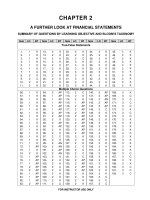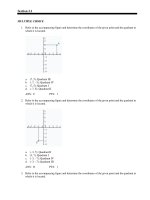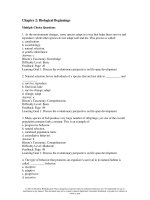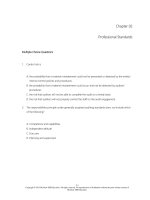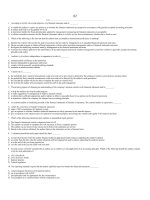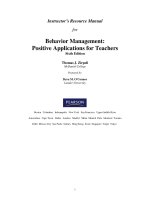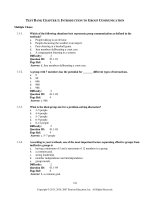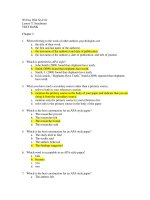Human anatomy media update 6th edition marieb test bank
Bạn đang xem bản rút gọn của tài liệu. Xem và tải ngay bản đầy đủ của tài liệu tại đây (326.88 KB, 17 trang )
Human Anatomy, 6e (Marieb/Mallat/Wilhelm)
Chapter 2 Cells: The Living Units
Matching Questions
Figure 2.1
Using Figure 2.1, match the following:
1) Rough endoplasmic reticulum
Answer: D
Diff: 2 Page Ref: 24
2) Nucleolus
Answer: A
Diff: 2 Page Ref: 24
3) Microvilli
Answer: C
Diff: 2 Page Ref: 24
4) Mitochondrion
Answer: B
Diff: 2 Page Ref: 24
1
Copyright © 2011 Pearson Education, Inc.
5) Golgi apparatus
Answer: E
Diff: 2 Page Ref: 24
Figure 2.2
Using Figure 2.2, match the following:
6) DNA molecule
Answer: A
Diff: 2 Page Ref: 38
7) Chromatid
Answer: D
Diff: 2 Page Ref: 38
8) Nucleosomes
Answer: C
Diff: 2 Page Ref: 38
2
Copyright © 2011 Pearson Education, Inc.
9) Histones
Answer: B
Diff: 2 Page Ref: 38
10) Metaphase chromosome
Answer: E
Diff: 2 Page Ref: 38
Match the following:
A.
B.
C.
D.
E.
Golgi apparatus
lysosome
rough endoplasmic reticulum
mitochondria
peroxisome
11) This organelle is involved in production of cellular energy.
Answer: mitochondria
Diff: 1 Page Ref: 32-33
12) This structure is characterized by folded membranes called cristae.
Answer: mitochondria
Diff: 2 Page Ref: 32-33
13) When a cell ingests a foreign cell, the vesicle fuses with this organelle.
Answer: lysosome
Diff: 3 Page Ref: 32
14) This membranous structure is the site of protein synthesis.
Answer: rough endoplasmic reticulum
Diff: 2 Page Ref: 31
15) This structure detoxifies a number of toxic substances.
Answer: peroxisome
Diff: 2 Page Ref: 33-34
16) Cisternae of this structure are continuous with the nuclear envelope.
Answer: rough endoplasmic reticulum
Diff: 3 Page Ref: 31
17) This structure has both a cis and a trans face.
Answer: Golgi apparatus
Diff: 3 Page Ref: 31-32
18) This membranous structure contains oxidase enzymes.
Answer: peroxisome
Diff: 3 Page Ref: 33-34
3
Copyright © 2011 Pearson Education, Inc.
19) These structures are often called the demolition crew of the cell.
Answer: lysosome
Diff: 2 Page Ref: 32
20) This structure primarily modifies products from the rough ER, and it is characterized by a
flattened stack of membranes.
Answer: Golgi apparatus
Diff: 2 Page Ref: 31-32
21) This structure is primarily a sac of powerful enzymes.
Answer: lysosome
Diff: 2 Page Ref: 32
22) This structure is defective in the disorder Tay-Sachs disease.
Answer: lysosome
Diff: 2 Page Ref: 32
23) This structure is numerous in liver and kidney cells.
Answer: peroxisome
Diff: 2 Page Ref: 33-34
24) This structure produces ATP.
Answer: mitochondria
Diff: 2 Page Ref: 32-33
25) This structure contains its own DNA.
Answer: mitochondria
Diff: 2 Page Ref: 32-33
True/False Questions
1) The smooth ER contains its own molecules of DNA.
Answer: FALSE
Diff: 3 Page Ref: 31
2) Hypercholesterolemia is an inherited disease in which the body's cells lack the protein
receptors that bind to cholesterol-delivering LDLs.
Answer: TRUE
Diff: 3 Page Ref: 28
3) Ribosomes consist of two subunits, each surrounded by a membrane.
Answer: FALSE
Diff: 2 Page Ref: 30-31
4
Copyright © 2011 Pearson Education, Inc.
4) Peroxisomes are important in detoxification of a number of toxic substances, for instance,
hydrogen peroxide.
Answer: TRUE
Diff: 2 Page Ref: 33-34
5) The nucleolus serves as the cell's ribosome-producing machine.
Answer: TRUE
Diff: 2 Page Ref: 37
6) Microtubules are composed of actin.
Answer: FALSE
Diff: 2 Page Ref: 34-35
7) Chromatin is composed of DNA wound around proteins known as actin.
Answer: FALSE
Diff: 2 Page Ref: 37
8) An example of a type of cell with high rates of mitosis is a cell of the skin.
Answer: TRUE
Diff: 2 Page Ref: 39
9) During the S phase, cells are characterized by rapid growth.
Answer: FALSE
Diff: 2 Page Ref: 38
10) During the G1 phase, DNA is replicated in the cytoplasm.
Answer: FALSE
Diff: 2 Page Ref: 38
11) Telomeres are structures that limit the maximum number of times cells can divide.
Answer: TRUE
Diff: 2 Page Ref: 43
12) Extended chromatin is tightly wound around histones.
Answer: FALSE
Diff: 2 Page Ref: 37
13) A mitotic spindle develops during early telophase of mitosis.
Answer: FALSE
Diff: 2 Page Ref: 40-41
14) During anaphase, the chromosomes are pulled toward the center of the cell.
Answer: FALSE
Diff: 2 Page Ref: 40-41
5
Copyright © 2011 Pearson Education, Inc.
15) Cytokinesis is the physical division of the cells.
Answer: TRUE
Diff: 2 Page Ref: 40-41
Multiple Choice
1) Mitosis refers only to nuclear division. Separation of the entire cell following mitosis is
A) meiosis.
B) karyokinesis.
C) cytokinesis.
D) telophase.
Answer: C
Diff: 2 Page Ref: 39
2) Phospholipids of the plasma membrane are arranged
A) around a central layer of cholesterol.
B) in a single layer with polar heads facing outwards.
C) with their nonpolar tails sandwiched between the heads.
D) with their polar heads sandwiched between the tails.
Answer: C
Diff: 2 Page Ref: 26
3) Which of the following cytoskeleton elements are the thickest?
A) microtubules
B) microfilaments
C) intermediate filaments
D) centrioles
Answer: A
Diff: 2 Page Ref: 34
4) Which of the following statements about integral proteins in the plasma membrane is false?
A) Most extend all the way through the membrane.
B) Some attach to the glycocalyx.
C) They determine which molecules are transported through the membrane.
D) They are more abundant by volume than the membrane phospholipids.
Answer: D
Diff: 2 Page Ref: 26
5) Which type of endocytosis engulfs the most specific type of molecule or material?
A) fluid-phase endocytosis
B) phagocytosis
C) pinocytosis
D) receptor-mediated endocytosis
Answer: D
Diff: 2 Page Ref: 27
6
Copyright © 2011 Pearson Education, Inc.
6) Hormones are secreted by
A) phagocytosis.
B) pinocytosis.
C) exocytosis.
D) osmosis.
Answer: C
Diff: 2 Page Ref: 27
7) Of the following, the only organelle that has a double membrane structure is the
A) centriole.
B) Golgi apparatus.
C) endoplasmic reticulum.
D) mitochondrion.
Answer: D
Diff: 2 Page Ref: 32-33
8) Functions of the Golgi apparatus include all of the following except
A) synthesis of lysosomes.
B) DNA replication.
C) plasma membrane formation.
D) production of secretory granules.
Answer: B
Diff: 3 Page Ref: 31-32
9) Which of the following statements about the rough endoplasmic reticulum is false?
A) It consists of stacked envelopes called cisternae.
B) It makes the digestive enzymes contained in the lysosomes.
C) It produces secretory granules.
D) It makes the integral proteins of the cell membrane.
Answer: C
Diff: 2 Page Ref: 31
10) Which of the following is not a cytoskeleton element?
A) microtubule
B) microfilament
C) intermediate filament
D) centriole
Answer: D
Diff: 1 Page Ref: 35
11) Which type of protein is required for exocytosis?
A) caveolin
B) coatomer proteins
C) clathrin
D) SNARE
Answer: D
Diff: 3 Page Ref: 28
7
Copyright © 2011 Pearson Education, Inc.
12) In chromatin, the DNA molecule wraps around proteins called
A) nucleotides.
B) codons.
C) integral protein.
D) histones.
Answer: D
Diff: 1 Page Ref: 37
13) In the cell life cycle, DNA is replicated during
A) interphase G1.
B) interphase S.
C) prophase I.
D) prophase II.
Answer: B
Diff: 2 Page Ref: 38
14) The longest arrays of microtubules that assemble on the centrioles during prophase form
filaments called
A) the mitotic spindle.
B) kinetochores.
C) asters.
D) the nuclear envelope.
Answer: A
Diff: 3 Page Ref: 40-41
15) During mitosis, contractions of the mitotic spindle serve to
A) separate the chromatids at the centromere.
B) pull together the replicated chromosomal strands.
C) re-form the nuclear envelope.
D) form the aster.
Answer: A
Diff: 2 Page Ref: 40-41
16) The ________ face of the Golgi apparatus is ________ to receive spherical vesicles from the
rough endoplasmic reticulum.
A) cis; convex
B) trans; concave
C) cis; flattened
D) trans; convex
Answer: A
Diff: 3 Page Ref: 31-32
8
Copyright © 2011 Pearson Education, Inc.
17) Which membranous organelle stores calcium and is considered the cell's membrane factory?
A) Golgi apparatus
B) rough endoplasmic reticulum
C) mitochondrion
D) peroxisome
Answer: B
Diff: 3 Page Ref: 31
18) Which organelle is important in neutralizing free radicals?
A) Golgi apparatus
B) lysosome
C) mitochondrion
D) peroxisome
Answer: D
Diff: 2 Page Ref: 33-34
19) Which of the following is the function of the nuclear envelope?
A) separation of nucleoplasm and cytoplasm
B) regulation of passage of substances into and out of the cell membrane
C) transcription of DNA
D) protein synthesis
Answer: A
Diff: 3 Page Ref: 36-37
20) Peroxisomes function to
A) form and degrade hydrogen peroxide.
B) store cellular free radicals.
C) produce pigments.
D) regulate membrane permeability.
Answer: A
Diff: 2 Page Ref: 33-34
21) Dyneins and kinesins
A) enable a cell to send out and retract extensions called pseudopods.
B) move organelles along microtubules through the cytoplasm.
C) push and pull on chromosomes to align them during metaphase of mitosis.
D) resist pulling forces that are placed on cells.
Answer: B
Diff: 3 Page Ref: 35
22) Cell division is analogous to
A) two buildings duplicating their parts and fusing.
B) a building duplicating its blueprint and then forming a new building by splitting in two.
C) a building forming another building by random accumulation of materials.
D) a building forming another building through a loss of some of its parts.
Answer: B
Diff: 2 Page Ref: 38
9
Copyright © 2011 Pearson Education, Inc.
23) The plasma membrane is important for all the following reasons except
A) it determines what substances enter and exit the cell.
B) it surrounds the cell contents.
C) it acts as a site for cell-to-cell interaction and recognition.
D) it is so thick and rigid that it offers some protection to the cell.
Answer: D
Diff: 3 Page Ref: 25-26
24) The plasma membrane is composed of all of the following except
A) glycoproteins.
B) tubulin protein.
C) cholesterol.
D) phospholipids.
Answer: B
Diff: 2 Page Ref: 25-26
25) Materials that are to be exocytosed by cells are packed by the
A) nucleosome.
B) ribosome.
C) Golgi apparatus.
D) mitochondrion.
Answer: C
Diff: 2 Page Ref: 31-32
26) Which of the following does not pass through nuclear pores?
A) chromatin
B) messenger RNA
C) proteins
D) water and electrolytes
Answer: A
Diff: 2 Page Ref: 37
27) Which of the following is associated with protein synthesis?
A) mitochondria
B) ribosomes
C) chloroplasts
D) smooth endoplasmic reticulum
Answer: B
Diff: 2 Page Ref: 30-31
10
Copyright © 2011 Pearson Education, Inc.
28) Ribosomes may be either free within the cytoplasm or bound to a channeling system known
as the
A) Golgi apparatus.
B) microtubule organizing center.
C) cytoskeleton.
D) rough endoplasmic reticulum.
Answer: D
Diff: 2 Page Ref: 30-31
29) Which is not part of interphase?
A) G1
B) G2
C) M
D) S
Answer: C
Diff: 1 Page Ref: 38
30) In the plasma membrane of cells, cholesterol acts to
A) stabilize the membrane.
B) make the membrane more resistant to freezing.
C) destabilize the membrane, leading to heart attacks.
D) participate in pinocytosis.
Answer: A
Diff: 2 Page Ref: 25-26
31) The endocytotic process in which tiny packets of fluid are brought into the cell is called
A) phagocytosis.
B) pinocytosis.
C) exocytosis.
D) xenocytosis.
Answer: B
Diff: 2 Page Ref: 27
32) The double membrane structure is unique to the
A) lysosome.
B) peroxisome.
C) mitochondrion.
D) nucleolus.
Answer: C
Diff: 2 Page Ref: 32-33
11
Copyright © 2011 Pearson Education, Inc.
33) Peroxisomes
A) are the toxic waste removal system of the cell.
B) are involved in the production of ATP.
C) contain some of the code necessary for their own duplication.
D) synthesize proteins for use outside the cell.
Answer: C
Diff: 2 Page Ref: 33-34
34) The stiffest elements of the cytoskeleton, analogous to the bones of the human body, are
A) microtubules.
B) microfilaments.
C) intermediate filaments.
D) the cytosol.
Answer: A
Diff: 2 Page Ref: 34
35) The mitotic spindle forms from the
A) nucleus.
B) Golgi apparatus.
C) centrioles.
D) nucleolus.
Answer: C
Diff: 2 Page Ref: 40-41
36) The nuclear envelope is continuous with the rough ER, but it differs from the rough ER in
that it
A) is not associated with ribosomes.
B) has unique pores.
C) consists of two membranes separated by a space.
D) consists of tubes, like the smooth ER.
Answer: B
Diff: 3 Page Ref: 36-37
37) Membrane-bound organelles have the same type of membrane as the plasma membrane
except
A) for the absence of a glycocalyx.
B) for the absence of cholesterol.
C) the nonpolar tails face outward.
D) they are all covered with ribosomes.
Answer: A
Diff: 3 Page Ref: 30
12
Copyright © 2011 Pearson Education, Inc.
38) In the process of phagocytosis, the organelles whose enzymes break down ingested foreign
cells are the
A) nucleoli.
B) smooth endoplasmic reticulum.
C) peroxisomes.
D) lysosomes.
Answer: D
Diff: 2 Page Ref: 32
39) During mitosis, the kinetochore microtubules of the mitotic spindle
A) pull on the chromatids and align them at the metaphase plate.
B) push on the chromatids.
C) anchor the centriole to the cell membrane.
D) push the two poles of the cell apart.
Answer: A
Diff: 2 Page Ref: 40-41
40) The theory proposing that aging results from the effects of free radicals is primarily a theory
of
A) wear and tear.
B) genetically programmed aging.
C) progressive disorder of immunity.
D) cross-linking of glucose.
Answer: A
Diff: 2 Page Ref: 42
41) The cytoskeletal elements that are analogous to the muscles of the body in that they help
generate contractile forces are
A) microtubules.
B) microfilaments.
C) intermediate filaments.
D) integral proteins.
Answer: B
Diff: 2 Page Ref: 34-35
42) Transcription of DNA requires the presence of
A) centrosomes.
B) extended chromatin.
C) histones.
D) nucleosomes.
Answer: B
Diff: 2 Page Ref: 37
13
Copyright © 2011 Pearson Education, Inc.
43) The process of cellular aging may involve each of the following except
A) accumulated damage by free radicals.
B) decreased production of lysosomes.
C) excessive metabolic rate.
D) progressive shortening of telomeres.
Answer: B
Diff: 3 Page Ref: 42
44) During what phase of mitosis does the mitotic spindle break down and disappear?
A) metaphase
B) anaphase
C) telophase
D) late prophase
Answer: C
Diff: 2 Page Ref: 40-41
45) The cytoskeletal elements that form a ring to "squeeze" the two daughter cells apart during
cytokinesis are
A) microtubules.
B) microfilaments.
C) intermediate filaments.
D) the microtrabecular lattice.
Answer: B
Diff: 2 Page Ref: 39, 40-41
46) During what phase of the cell cycle is the DNA duplicated?
A) metaphase
B) anaphase
C) interphase
D) prophase
Answer: C
Diff: 2 Page Ref: 38
47) The plasma membrane is
A) a single-layered membrane that surrounds the nucleus of the cell.
B) a single-layered membrane enclosing the plasma.
C) the membrane surrounding the cell.
D) a membrane composed of tiny shelves or cristae.
Answer: C
Diff: 2 Page Ref: 25-26
14
Copyright © 2011 Pearson Education, Inc.
48) The cell that gathers information and controls body functions is a
A) macrophage
B) fat cell
C) sperm cell
D) neuron
Answer: D
Diff: 2 Page Ref: 42
49) The temporary structures in the cytoplasm include all of the following except
A) pigments
B) glycosomes
C) lipid droplets
D) the Golgi apparatus.
Answer: D
Diff: 2 Page Ref: 35
50) Which of the following is an inclusion, not an organelle?
A) lysosome
B) microtubule
C) mitochondrion
D) glycogen
Answer: D
Diff: 2 Page Ref: 35
Short Answer Questions
1) This phase is the physical division of two cells during mitosis.
Answer: cytokinesis
Diff: 2 Page Ref: 40-41
2) What is the mechanism by which substances move from the cytoplasm to the outside of the
cell?
Answer: exocytosis
Diff: 3 Page Ref: 27
3) Cell aging may be related to production of what chemicals produced by the mitochondria?
Answer: radicals (free radicals)
Diff: 2 Page Ref: 42
4) This is the collective name for short carbohydrates on the extracellular surface of integral
proteins, which help cells recognize each other.
Answer: glycocalyx
Diff: 2 Page Ref: 26
5) This is the name of a cluster of DNA wrapped around a group of eight histones.
Answer: nucleosome
Diff: 2 Page Ref: 38
15
Copyright © 2011 Pearson Education, Inc.
6) This is the phase in which a cell grows and carries on all its usual activities except for
division.
Answer: interphase
Diff: 1 Page Ref: 38
7) These are the smallest living units in the body.
Answer: cells
Diff: 2 Page Ref: 24
8) This is the outer physical boundary of a human cell.
Answer: plasma membrane (plasmalemma)
Diff: 1 Page Ref: 25-26
9) This is the name for the currently held theory describing the plasma membrane.
Answer: fluid mosaic model
Diff: 2 Page Ref: 26
10) The plasma membrane is primarily composed of this type of fat molecule.
Answer: phospholipid
Diff: 2 Page Ref: 26
11) This network of rods running throughout the cytosol acts as a cell's bones, muscles, and
ligaments.
Answer: cytoskeleton
Diff: 2 Page Ref: 34
12) This is the mechanism by which large particles enter a cell.
Answer: endocytosis
Diff: 2 Page Ref: 27
13) This is the diffusion of water molecules across a membrane.
Answer: osmosis
Diff: 3 Page Ref: 27
14) This is the type of protein involved in transport mechanisms across the plasma membrane.
Answer: integral proteins
Diff: 3 Page Ref: 26
15) This is a genetic disease that leads to an accumulation of undigested glycolipids in the
lysosomes.
Answer: Tay-Sachs disease
Diff: 2 Page Ref: 32
16
Copyright © 2011 Pearson Education, Inc.
Essay Questions
1) Differentiate phagocytosis from receptor-mediated endocytosis.
Answer: In phagocytosis, the cell extends pseudopods and engulfs the particle. In receptormediated endocytosis, the cell membrane forms inpocketings called caveolae lined with the
protein clathrin and binds to membrane receptors, causing it to be enveloped.
Diff: 2 Page Ref: 27-28
2) Describe the action of exocytosis and the SNAREs.
Answer: Exocytosis is the process by which a cell expels materials. These molecules are within
a lipid-bound secretory vesicle with a vesicle SNARE, which binds to the plasma membrane
SNARE, causing the vesicle phospholipid molecules to fuse with the plasma membrane
phospholipid molecules. The molecules are expelled from the cell.
Diff: 3 Page Ref: 28
3) Describe the two checkpoints that occur during interphase.
Answer: The first checkpoint, G1, ensures that the cell has grown enough and replicated the
necessary organelles and other structures to synthesize DNA. The second checkpoint, G2,
checks to see whether errors occurred during DNA synthesis.
Diff: 3 Page Ref: 38
4) Describe the mitochondria.
Answer: These are long and thin organelles, contain their own DNA involved in their own
replication, and move within the cell to sites where they are needed. They produce ATP
molecules, which are the equivalent of cellular energy. They are bound by two membranes. The
inner one is highly folded into ristae, where many of the critical molecules involved in energy
production are imbedded.
Diff: 2 Page Ref: 32-33
5) Describe the three major types of cytoskeletal elements.
Answer: Microtubules are the largest and are formed by the protein tubulin. They are stiff, but
bendable. Microfilaments are the thinnest. They are strands of the protein actin, are contractile,
and are typically very labile. Intermediate filaments are of intermediate diameter. They are very
stabile and permanent, functioning as support structures as well as holding cells together.
Diff: 2 Page Ref: 34-35
17
Copyright © 2011 Pearson Education, Inc.
